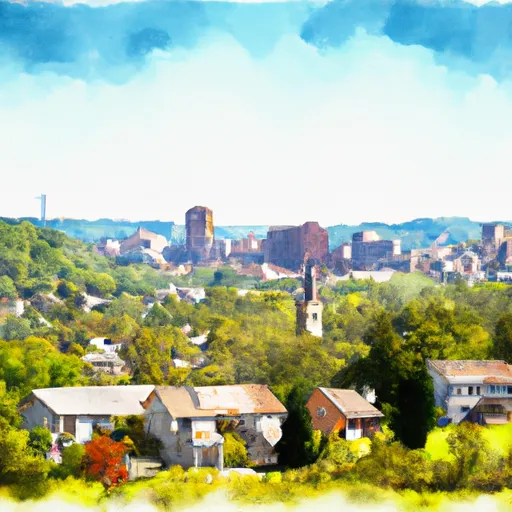-
 Snoflo Premium
Snoflo Premium
Get unlimited access to all our content
With no Ad interruptions! - Start Your Free Trial Login with existing account
Spring-Run
Eden Index
Climate
8.1
•
Recreation
3.1
•
Community
•
Safeguard
4.3/10

Spring-Run, Pennsylvania is a small rural community located in Franklin County. It experiences a humid continental climate, characterized by warm summers and cold winters. Average temperatures range from the mid-20s °F (-4 °C) in winter to the mid-80s °F (29 °C) in summer. Precipitation is evenly distributed throughout the year, with an annual average of around 40 inches (102 cm). Snowfall is common in winter, with an average of 30 inches (76 cm) annually.
The area surrounding Spring-Run boasts abundant hydrology constituents. The community sits near the confluence of several streams, including Antietam Creek, which provides opportunities for fishing, boating, and other water activities. The local waterways are also home to a diverse range of aquatic wildlife, making it a popular spot for nature enthusiasts and birdwatchers.
Outdoor recreation opportunities in the area are plentiful, with numerous hiking trails, camping sites, and parks. Nearby Tuscarora State Forest offers miles of trails for hiking and mountain biking. There are also opportunities for hunting and wildlife photography. In addition, the area's natural beauty, including rolling hills and picturesque landscapes, provides a serene setting for outdoor activities and relaxation.
What is the Eden Index?
The Snoflo Eden Index serves as a comprehensive rating system for regions, evaluating their desirability through a holistic assessment of climate health, outdoor recreation opportunities, and natural disaster risk, acknowledging the profound impact of these factors on livability and well-being.
Climate Health Indicator (CHI): 8.1
Spring-Run receives approximately
1101mm of rain per year,
with humidity levels near 83%
and air temperatures averaging around
11°C.
Spring-Run has a plant hardyness factor of
6, meaning
plants and agriculture in this region thrive during a short period during spring and early summer. Most
plants will die off during the colder winter months.
By considering the ideal temperature range, reliable water supplies, clean air, and stable seasonal rain or snowpacks, the Climate Health Indicator (CHI) underscores the significance of a healthy climate as the foundation for quality living.
A healthy climate is paramount for ensuring a high quality of life and livability in a region, fostering both physical well-being and environmental harmony. This can be characterized by ideal temperatures, reliable access to water supplies, clean air, and consistent seasonal rain or snowpacks.
Weather Forecast
Streamflow Conditions
Potomac
Area Rivers
Potomac
Snowpack Depths
Potomac
Reservoir Storage Capacity
Potomac
Groundwater Levels
Recreational Opportunity Index (ROI): 3.1
The Recreational Opportunity Index (ROI) recognizes the value of outdoor recreational options, such as parks, hiking trails, camping sites, and fishing spots, while acknowledging that climate plays a pivotal role in ensuring the comfort and consistency of these experiences.
Access to outdoor recreational opportunities, encompassing activities such as parks, hiking, camping, and fishing, is crucial for overall well-being, and the climate plays a pivotal role in enabling and enhancing these experiences, ensuring that individuals can engage in nature-based activities comfortably and consistently.
Camping Areas
| Campground | Campsites | Reservations | Toilets | Showers | Elevation |
|---|---|---|---|---|---|
| Greenbrier State Park | 165 | 909 ft | |||
| Cowans Gap State Park | None | 1,223 ft | |||
| Fowlers Hollow State Park | None | 900 ft | |||
| Brunswick City Campground | None | 219 ft | |||
| Gambrill State Park | 34 | 1,186 ft |
Nearby Fishing
Nearby Ski Areas
Catastrophe Safeguard Index (CSI):
The Catastrophe Safeguard Index (CSI) recognizes that natural disaster risk, encompassing floods, fires, hurricanes, and tornadoes, can drastically affect safety and the overall appeal of an area.
The level of natural disaster risk in a region significantly affects safety and the overall livability, with climate change amplifying these risks by potentially increasing the frequency and intensity of events like floods, fires, hurricanes, and tornadoes, thereby posing substantial challenges to community resilience and well-being.
Community Resilience Indicator (CRI):
The Community Resilience Indicator (CRI) recognizes that education, healthcare, and socioeconomics are crucial to the well-being of a region. The CRI acknowledges the profound impact of these elements on residents' overall quality of life. By evaluating educational resources, healthcare accessibility, and economic inclusivity, the index captures the essential aspects that contribute to a thriving community, fostering resident satisfaction, equity, and social cohesion.

